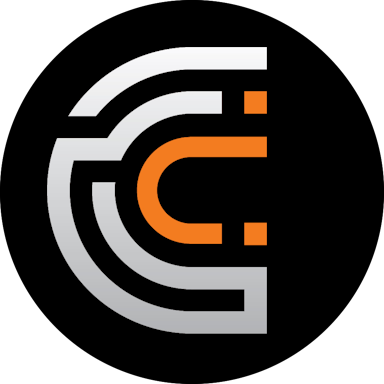
Chain Abstraction: Shaping User-Centric Blockchain Interactions
I: Introduction
The blockchain landscape is rapidly evolving. In Understanding the Future of Modular and Monolithic Blockchains, we laid out how there is a transformative shift towards a multi-chain future, driven by innovations like rollup Software Development Kits (SDKs) and alternative Data Availability (DA) and execution layers. It’s impossible to be certain whether the popular choice for builders will be application-specific or general purpose Layer 1s (L1s) or Layer 2s (L2s), or some other yet to be thought of architecture – but it is evident that we are moving towards a multi-chain future. Whether we find ourselves in a landscape with 10 dominant chains or 10,000, what we know for certain is that these chains will need to communicate with each other, and we need solutions to the fragmented state and liquidity across numerous chains.
Builders are rapidly paving the way for an onchain revolution: the rise of chain abstraction. In the near future, the technical intricacies of whether an application uses alternative DA or a shared sequencer will fade into the background. Users simply want the seamless, efficient experience they’ve grown accustomed to with Web2 applications. Similarly to how users don’t think or care about which server their websites are running on, the underlying blockchain a web3 app is deployed on should be abstracted away from the end-user.
II: Fragmentation is the Problem
Fragmentation is turning into a major hindrance to blockchain mass adoption. As builders embrace the simplicity of building new blockchains through Rollup-as-a-Service (RaaS) platforms and tools like the Cosmos SDK, which simplifies the development of a sovereign L1, we’re seeing a cambrian explosion in the number of chains deployed. The problem with having many different chains and settlement layers is that liquidity and state are fragmented not only across L1s, but also across rollups that settle back to the same L1. As the ecosystem grows, this will only persist
This fragmentation creates a UX pain point. While there are ways to move assets and messages between L1s, they’re clunky and expensive, and the industry has not adopted a common standard, with existing solutions all having different trust assumptions. Rollups within the same ecosystem can communicate with each other more with lower latency and less trust assumptions, but the interactions are far from perfect. Acknowledging the issue of fragmentation, in the next section, we’ll evaluate the balancing act between security, speed, and cost in existing interoperability solutions.
III: Current Interoperability Solutions and Their Tradeoffs
Bridges and general message passing protocols are currently the dominant interoperability solutions. These can broadly be grouped into two categories: Interoperability across disparate ecosystems, and interoperability within a single ecosystem. Each of the solutions mentioned below will have their own differentiations and tradeoffs, mainly related to security, speed, and cost. Users have different preferences related to security tradeoffs or potential censorship they are willing to bear in favor of less latency. Additionally, ecosystem and chain support, alongside integrations with popular wallets and dApps will give certain solutions a first mover advantage.
Interoperability Across Different Ecosystems
Interoperability across disparate blockchain ecosystems such as Ethereum, Cosmos, and Solana remains a central challenge. Cross chain arbitrary message passing (AMP) protocols have emerged to solve these problems. These interoperability solutions allow for any piece of data including tokens, the state of a chain, a contract call, or governance votes to be moved from chain A to chain B. Axelar and LayerZero are the main players in this space. Cosmos IBC is another protocol designed for securely exchanging data between independent blockchains.
IBC
Inter-Blockchain Communication (IBC) enables blockchains within and outside the Cosmos ecosystem to transfer tokens and exchange information. IBC enables data transfer through a set of functions specified in the Interchain Standards (ICS). IBC is most widely used within the Cosmos ecosystem and allows users to easily swap or stake tokens across IBC-enabled chains via platforms like the Osmosis DEX. IBC consists of two layers: TAO and APP. TAO handles transport, authentication, and ordering, while APP is the application layer. IBC allows blockchains to exchange information directly through dedicated channels that include a light client for verifying the validity of the state sent by the origin blockchain.
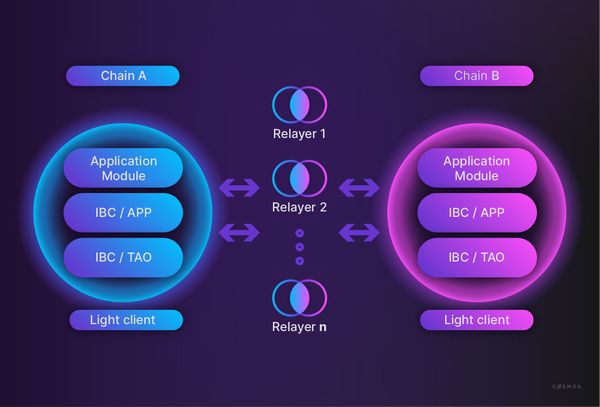
The chains depend on relayers, which can serve one or more channels, to communicate. Relayer algorithms are offchain processes responsible for relaying data between two chains by scanning the state of each chain and executing on the destination chain as allowed by the protocol. TAO facilitates smooth cross-chain transfers with the following core functionalities:
Transport: leverages on and off-chain components to efficiently move IBC data packets across chains.
Authentication: Both chains use light clients to verify the legitimacy of data packets, ensuring they come from the intended source and reach the proper destination.
Ordering: Blockchains rely on ordering to ensure secure delivery and processing of packets in the order they were sent, maintaining integrity of the entire process.
IBC solves the problem of cross-chain communication. The specifications of the interchain standards do not limit the network topology or consensus algorithm, meaning IBC can be used with a wide range of blockchains, reducing trust assumptions to the security of the participating chains. Some of the downsides here are that an IBC channel is a trusted setup, as you are trusting the security of the channel owner. Additionally, it takes time and development for new interchain standards to be built, as new application-specific features need to be built separately above the IBC/TAO layer.
LayerZero
LayerZero is a popular message passing protocol with the goal of building an "omnichain future". It is a low-level message passing protocol upon which dApps can build. In v1 there were oracles responsible for capturing the block header from the source chain and relayers providing a proof that the message is valid and accurate. In v2 these have been replaced by Decentralized Validator Networks (DVN) and Executors, which are permissionless to run. The DVN role empowers any entity capable of verifying cross-chain data packets to join LayerZero as a DVN. Adapters are available from Axelar and CCIP, and other adapters are on the roadmap allowing developers to integrate any type of bridge, middle chain, oracle, or other verification method in LayerZero. This avoids vendor lock-in at the security set level and aligns with the modular thesis. Executors replace the relayer and separate execution from verification. These Executors facilitate automated execution on the destination chain, simplify gas payments, and offer customizable gas settings.
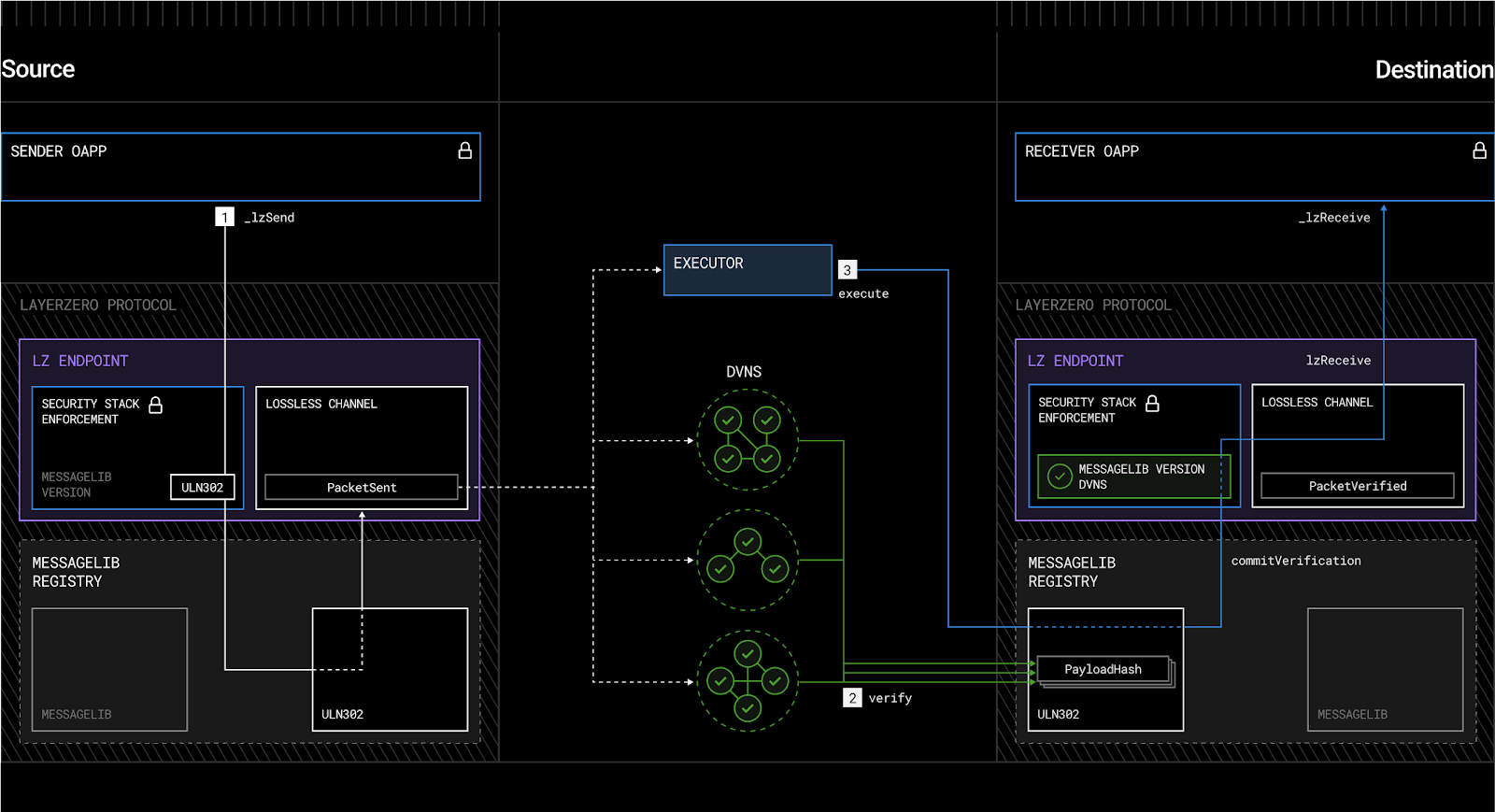
A simple cross-chain USDC transfer example is as follows:
An action where the user is locking USDC is committed on Chain A and sent to the endpoint.
The endpoint interacts with the configured DVNs for message verification and Executors for message execution.
DVNs verify the payload hash securely, while executors handle the execution process.
The resulting transaction that requires USDC to be minted on Chain B is received by the endpoint and committed.
With DVNs and adaptors, LayerZero acts as a quasi-aggregator of verification methods. For example, developers can opt to verify messages through shared security adapters like Axelar and CCIP or go with enterprise signers like Google Cloud and Blockdaemon, or some combination of these options. However, users must trust the security of the DVNs in ensuring message integrity.
Axelar
Axelar operates similarly to LayerZero, with the distinction that the oracles are secured by their PoS network of distributed validators. All nodes in the validator set run light clients for supported blockchains so that they can agree on the current state of other chains. This allows Axelar to manage threshold signature accounts on each chain which can be used to call contract functions on other chains.

Axelar has two core components:
Cross-Chain Gateway Protocol: This is part of the Axelar network itself, maintained by the PoS network. This layer consists of gateways that act as smart contracts to connect the Axelar network with other blockchains. Validators handle these operations by reading incoming operations, coming to consensus, and writing to the gateway on the destination chain to execute a transaction.
Axelar SDKs/APIs: This layer exposes the core infrastructure layer of Axelar to developers on other chains. The APIs enable developers to send generalized messages across chains to create cross-chain transactions such as transfers and cross-application function calls.
Axelar's Cross-Chain Gateway Protocol sets a universal standard for consensus across all message transfers, differing from LayerZero's approach which leaves consensus and execution to individual applications. Axelar does have a few tradeoffs such as reliance on the intermediate consensus layer that comes with additional operations and overhead. Additionally, there are varying validators within the validator set for different chains. For a new chain to be added, Axelar requires 80% of the validators to run a node on the chain, so it is possible for some chains to have a lower number of validators securing transactions.
CCTP
CCTP is a standardized bridge protocol operated by CMT Digital portfolio company Circle, that lets users make native USDC transfers by minting and burning USDC between supported chains. CCTP functions in three steps: USDC is burned on the source chain, Circle issues an attestation or proof of the burn, and the attestation is used to start the minting process on the destination chain. The same amount of USDC that was burned on the source chain is then created and sent to the recipient’s wallet address on the destination chain. In many bridging solutions today, users may be using wrapped versions of USDC, like USDC.e which is minted on Avalanche after bridging USDC from Ethereum to Avalanche. CCTP allows anyone to burn and mint native USDC on any chain, meaning you can always redeem the USDC on that chain for the underlying collateral. This shifts the trust assumption from a bridge’s security model to Circle as the entity honoring your redemptions and guarantees consistent asset value across different blockchains.
With CCTP's growth and increasing support for new ecosystems, chains deploy a USDC token contract that conforms to the CCTP standard. CCTP adoption will result in a higher share of native USDC issuance and lower share of bridged or synthetic USDC. What's unique about CCTP is that since it sits at a lower level of the stack than the messaging protocols, these protocols can integrate CCTP for cross-chain USDC transactions. The following diagram shows how CCTP has greatly reduced the complexity of a cross-chain swap done on Axelar:

Here is a more detailed breakdown highlighting some of the above message passing protocol designs and distribution:
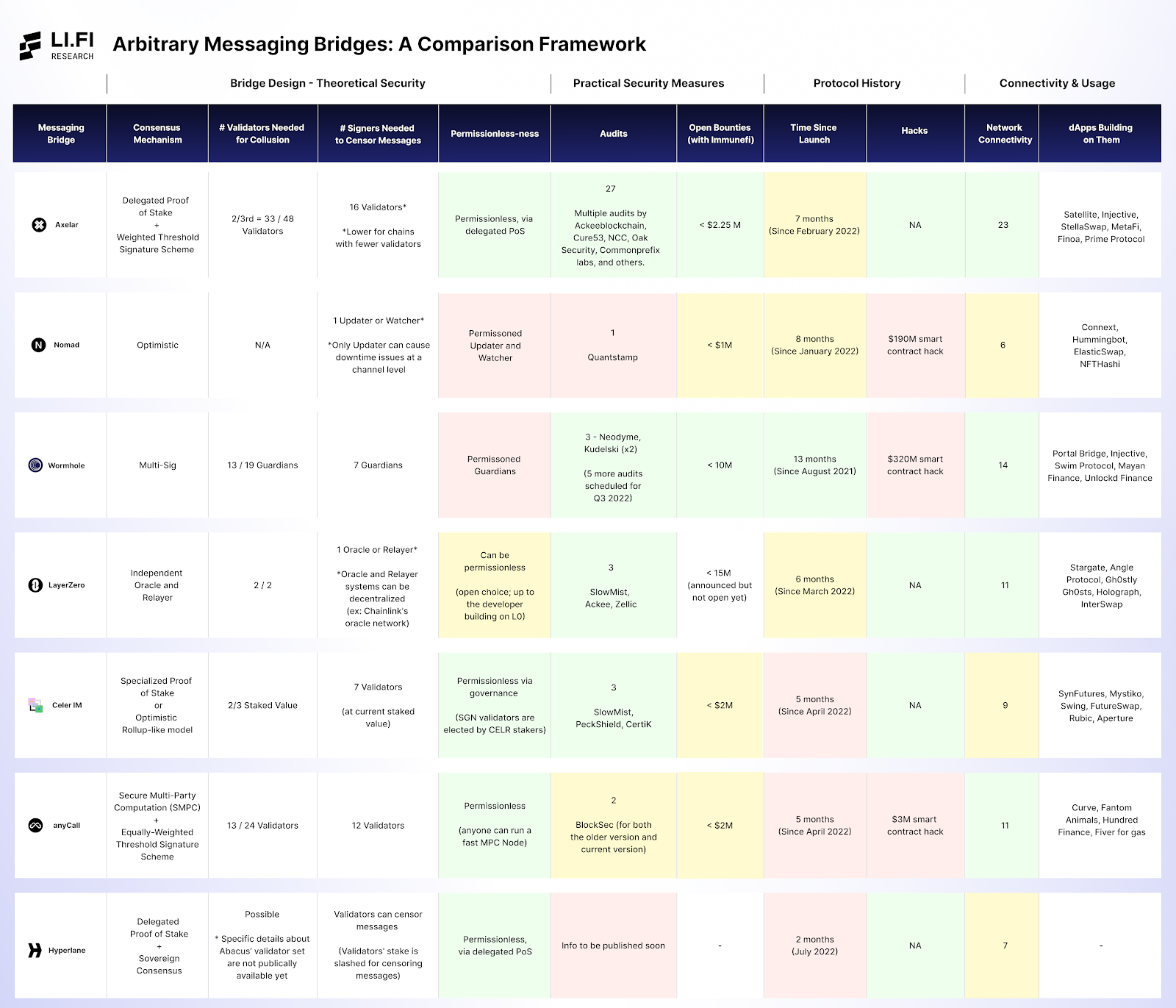
For a more in depth breakdown on AMPs, refer to this blog post by LI.FI.
Interoperability Among Rollups or Chains within the Same Ecosystem
Shared Sequencers
For chains and rollups within the same ecosystem, interoperability solutions focus on seamless and low-latency communication and transactions with certain inclusion guarantees. Shared sequencers such as Espresso and Astria are working to reduce the centralization risk of single sequencers and support interoperability between rollups. In this setup, transactions are pooled across rollups, with the shared sequencer handling the ordering of transactions. This makes atomic cross-rollup composability possible as the sequencer can order transactions on chains that use the same sequencer. Atomic inclusion means that either all transactions in an atomic set are included, or none are. For example, if you want to send USDC from chain A to chain B, the shared sequencer can ensure that the transaction where USDC is locked/burned on chain A is ordered before the transaction where the USDC is minted on chain B, and both are executed.
AggLayer
Polygon's AggLayer is a decentralized aggregation protocol that ensures safety for low-latency, cross-chain transactions, and a unified bridge. This is intended to be a layer in between the underlying settlement layer and the fragmented execution environments. Chains submit proofs and state updates to the AggLayer where proofs are then aggregated and settled on Ethereum.
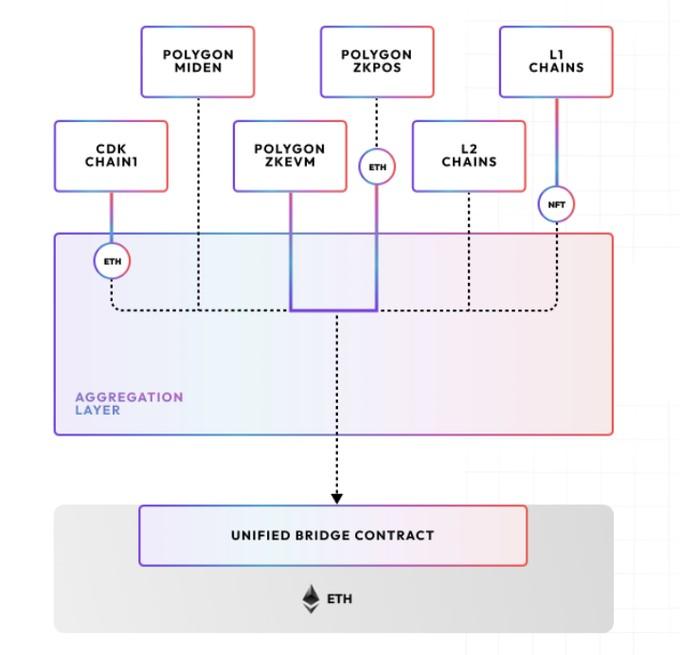
At a high level, the AggLayer is collecting proofs from several ZK rollups for them to verify each other’s state without waiting for finality on Ethereum. From the perspective of Ethereum, rollups are smart contracts holding a state root, and currently many rollups exist each with their own native bridge. In the current L2 ecosystem, cross-chain transactions require a withdrawal to Ethereum. This means in the best case you are waiting for Ethereum finality, and in the worst case for optimistic chains you are bearing a 7-day delay. The AggLayer's unified bridge changes this. Only a single bridge contract on Ethereum is required for all connected chains, with each chain holding a copy of the unified bridge root. This enables cross-chain transactions that don't require third-party bridge trust assumptions or withdrawing to Ethereum. The current trade offs are that the AggLayer introduces high latency and dependency on Polygon’s technology. Integrating chains must consider the trade-off between enhanced interoperability and potential impacts on chain sovereignty, as adherence to Polygon’s standards may influence their autonomous operations
Across Protocol
Across protocol is one of the most popular projects secured by UMA's Optimistic Oracles. It differs from other bridges due to its optimistic design. While most bridges keep local pools on each chain to provide liquidity, Across aggregates all liquidity on Ethereum. Across has a network of relayers that verify the user deposits on the source chain and compete to provide the corresponding funds to the user on the destination chain. Relayers then submit a proof of the user deposit to UMA's oracle, and batched reimbursements are sent. The user is effectively taking a loan from the relayer and pays a small fee as relayers optimistically fill orders. Across consistently has lower fees and faster transfer times than other bridges in the EVM ecosystem, as seen below:
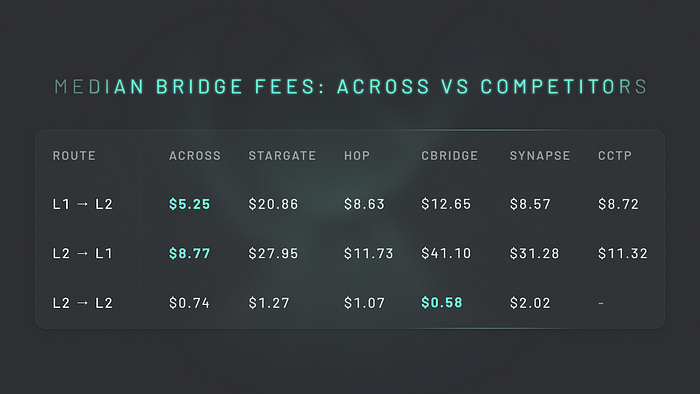
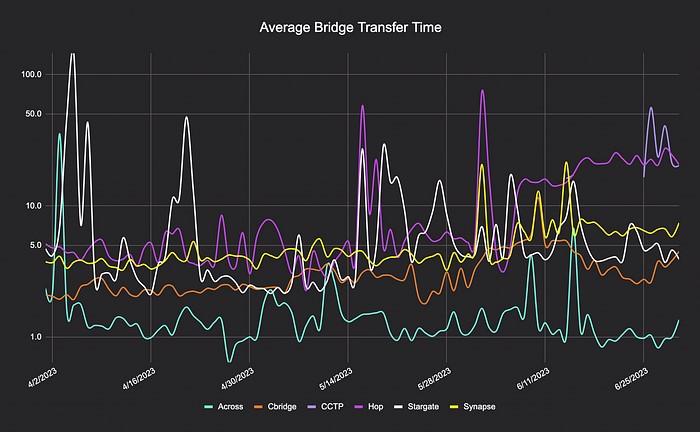
Across' superior performance highlights the power of optimistic systems. Other bridge solutions opt for mechanisms such as mint and burn or rely on trust assumptions of oracles and relayers, and such designs come with tradeoffs.
IV: A Chain Abstracted Future
While there are copious resources being invested into solving interoperability and fragmentation across L1 ecosystems and rollups, these solutions fall short as the end-user experience is still painful. Sub-second bridging times and atomic cross-chain transactions are nice, but interacting with a different wallet for every ecosystem is not.
Engaging with blockchain technology should be as straightforward as using any mobile app today. If anything, blockchains should strive to offer a more integrated user experience than our fragmented financial systems today. Users should be able to effortlessly move assets, execute transactions, and explore dApps without ever worrying about the underlying blockchain infrastructure. Currently, users must navigate a labyrinth of wallets, interfaces, assets, and protocols, each with their own security considerations and trust assumptions. This fragmentation not only hampers usability but increases the risk of user error and loss of assets.
The key to unlocking the next wave of crypto adoption lies not only in making things cheaper and faster. Complexities of blockchains need to be abstracted away, offering users a smooth and intuitive UX. The challenge builders in the space are facing is clear. Many are redirecting their focus to develop solutions that prioritize user experience - building interfaces where users can trustlessly interact with any blockchain, unaware of the intricate technologies working under the hood. These approaches will not only accelerate adoption but also ensure that crypto fulfills its promise of creating a more open, transparent, and inclusive digital future.
Chain Abstraction Key Elements (CAKE) Framework
The existing interoperability solutions mentioned in Part III are undoubtedly building towards a smoother and friendlier UX. However, the issue remains that users still have their liquidity fragmented across chains and wallets, and to move across these chains, users must educate themselves on the aforementioned interoperability solutions and decide which protocols to use based on which speed and security tradeoffs they are willing to make. In a chain abstracted world, these decisions will be abstracted away from the user, and they will simply need to specify the intent or desired outcome of their transaction, while a separate entity handles the complexities under the hood. The CAKE framework proposes that the key elements of a chain abstracted future are the application layer, permission layer, solver layer, and settlement layer.

In a chain abstracted world, a user visits an application, connects their wallet, signs for their desired operation, and waits for settlement. All the complexities of interoperability such as acquiring the required assets to the target chain and the final settlement get abstracted away from the user, being processed in the three infrastructure layers of the CAKE:
Permission Layer: This is where a user connects their wallet and specifies their intent. Checks are in place to see if the user has the necessary permissions or enough funds to execute a transaction. This layer should be able to read on the source chain and execute transactions on the target chain. The intent specifies the transaction outcome, but the path of the transaction is decided by the solver layer.
Solver Layer: This layer involves solvers - sophisticated third-party entities - that compete to fulfill user intents by providing fee quotes and confirmation times, balancing user experience with security trade-offs. This solving process is crucial for cross-chain transactions where asynchronous sub-transactions may fail. This asynchronicity creates a cross-chain trilemma involving fees, execution speed, and execution guarantee.
Settlement Layer: After the transaction is signed by the user, the settlement layer finalizes the execution. In a cross-chain transaction, it involves bridging the user's assets to the target chain then executing the transaction. If a protocol uses sophisticated solvers for certain operations, they can bring their own liquidity and execute the operation for the user without bridging.
In a chain abstracted future, the infrastructure layers mentioned above must be unified. The CAKE R&D group has spent significant time researching teams both explicitly and implicitly working on chain abstraction. This group has noticed six different chain abstraction implementations gaining PMF that have the potential to compose with each other if built right:

The key insight from the research team emphasizes the necessity of a unified standard for cross-chain intents. The current competitive landscape inevitably leads to duplicate efforts, but importantly encourages competition and innovation. By converging and working together on a single standard, we can enhance user experience and comprehension, streamline collaborations among solvers, oracles, and intents, and ease the integration process for wallets. This unified approach will not only eliminate inefficiencies but also foster a more cohesive builder ecosystem.
NEAR Account Aggregation
NEAR is working on a solution to abstract away the separate accounts and wallets on each blockchain that result in complex account management and security. NEAR's Account Aggregation tooling is being built to give the user the ability to transact on any blockchain through a single account and interface.

The unique selling point is that no bridge or smart contracts are needed, all transactions are signed from your NEAR account. This will significantly defragment Web3 for app users and increase the ability to move across networks and applications with ease. NEAR's Account Aggregation consists of 3 core technologies:
NEAR Account: Account Abstraction account for smooth onboarding and recovery
Chain Signatures: Enables the NEAR network nodes to use MPC to jointly sign transactions and messages.
Intent Relayers: Parties that can execute the intent of the user on different chains.
NEAR abstracts signing through their MPC node network for private keys. These nodes use threshold cryptography to hold only parts of each key and can sign messages for the user without exposing the entire key to one node. There are 5 steps for a user to sign a transaction on another chain from their NEAR account:
Construct the address that will be controlled on the target blockchain.
Create the transaction or message to be signed.
Call the NEAR multichain contract requesting it to sign the transaction.
Reconstruct the signature from the MPC service's response.
Send the signed transaction to the destination chain for execution.

Intent Relayers and Chain Signatures simplify cross-chain transactions by allowing users to perform an action on NEAR and have the equivalent transaction executed on another chain. This approach avoids the complexities of multiple tokens, swaps, or understanding detailed blockchain operations. Users initiate transactions on NEAR and through the relayer and chain signature smart contract, the intended action is completed without direct interaction or paying fees on the destination chain. By adding Chain Signatures and Intent Relayers to the already robust NEAR account model, NEAR is poised to usher in this new era of chain abstraction.
Particle Network
Particle Network aims to address the ongoing fragmentation by introducing Universal Accounts. Universal Accounts allow users to manage their identity and assets across various chains by only interacting with a single account. Particle Network's new modular L1 acts as a settlement and coordination layer for Universal Accounts, enabling a multi-chain experience mirroring the unified liquidity of a single chain. Particle's Wallet Abstraction services have amassed 17 million users across 900 dApps, securing $2 billion across 56 chains. All these wallets will be seamlessly onboarded to the Particle Network L1 when launched where they can act as Universal Accounts.
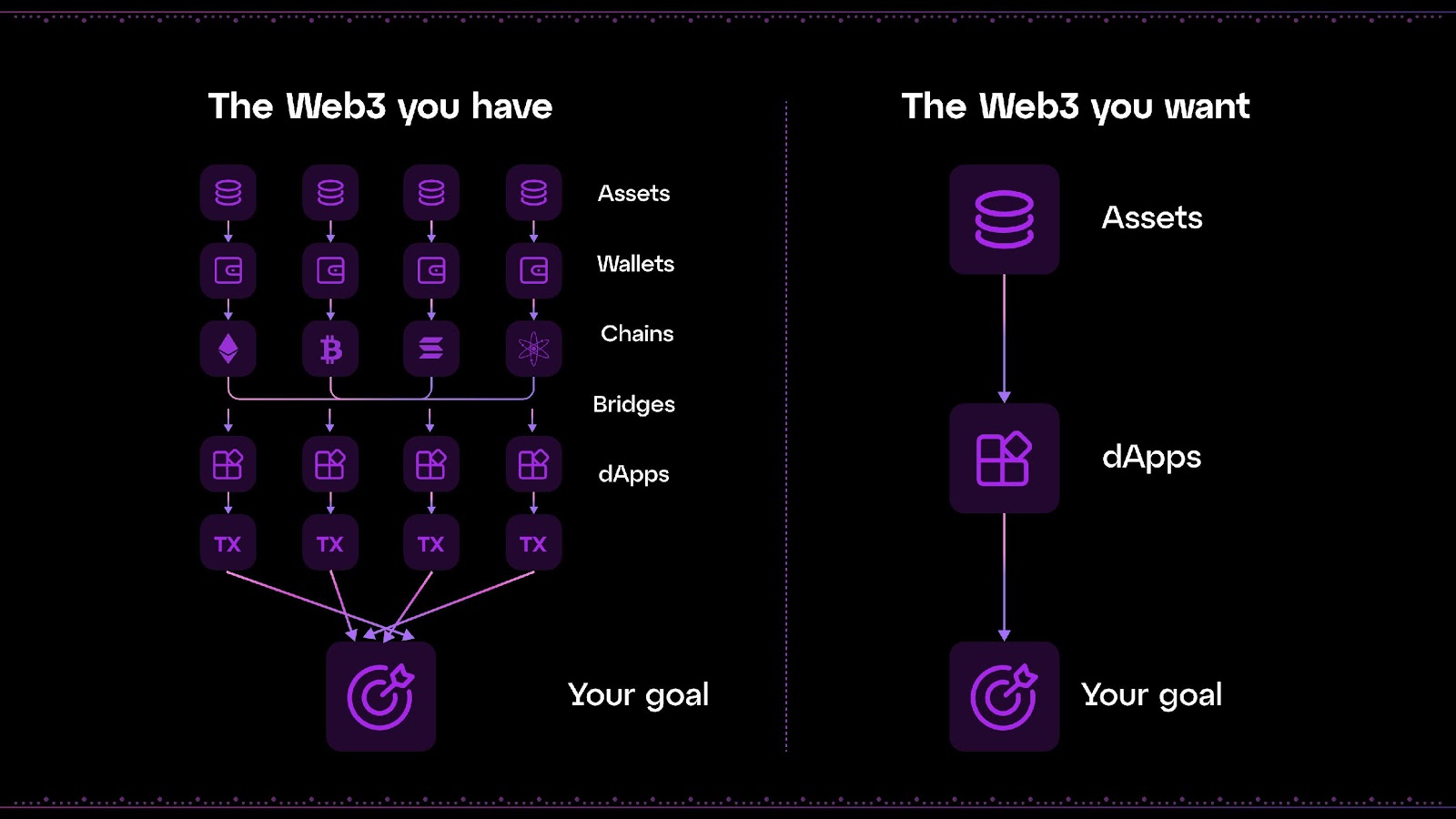
Particle Network's modular L1 is built using the Cosmos SDK to be IBC compatible and to retain its sovereignty while outsourcing key functions like validation and data availability (DA) to specialized actors. It is based on Rollkit and uses Berachain's Polaris framework for EVM compatibility. The following functionalities support the design of Universal Accounts:
Master Keystore Hub: The network serves as a central hub that coordinates the deployment and updates of smart contracts across all networks. It ensures all Universal Account instances are synchronized, maintaining identical settings and states network wide. The hub stores account settings centrally to manage and synchronize any changes in instances across networks seamlessly.
Decentralized Messaging Network (DMN): The L1 features a DMN that verifies and sends cross-chain messages. It's built on LayerZero's architecture, including a DVN optimizing for high-value transactions where speed is less important, and security is prioritized. For quicker transactions, it uses Hyperlane for optimistic rapid cross-chain communication and incorporates IBC and Across to connect with various blockchains in the Cosmos, Solana, and Bitcoin ecosystems. All these components are wrapped together into a unified messaging channel to create a "Universal IBC" for fast and secure cross-chain transactions.
Decentralized Bundler: Current ERC-4337 account abstraction bundlers are centralized and censorable, so Particle Network has designed a fully decentralized bundler. The bundler takes transactions from a public UserOp mempool and Operators participating in the custom Bundler AVS will process and relay them.
This kind of chain abstraction is the missing piece in the transition from Web3's early fragmented stage to a Web2-like mainstream stage.
Wallet UX
While the above infrastructure layers are working to improve cross-chain interoperability under the hood, the user interface layer needs to be simplified in order to onboard the next wave of users. The user interface of wallets needs to redirect user intents to the underlying infrastructure layers specified in the CAKE framework. Using NEAR's account aggregation, users will be able to interact with all supported chains through their native NEAR wallet and account. Similarly, certain EVM wallets like Light and Avocado are working on enabling users to seamlessly interact with any EVM chain as if you're using a single network.
The challenge in onboarding users to these new chain abstracted wallets is that the relationship between a user and their wallet is very sticky. MetaMask is still breaking record numbers of active users despite wallets with better UX like Rabby and new chain abstraction wallets coming to market. Onboarding users to a chain abstracted future will necessitate the establishment of unified standards for cross-chain intents and a seamless UX for defining these intents. Moreover, strong business development efforts from wallets specializing in chain abstraction will be crucial. These efforts must demonstrate to users that they can engage with blockchains without navigating the underlying complexities, like how we use web2 applications today without considering the cloud providers operating behind the scenes.
V. Conclusion
The evolution towards a chain abstracted future promises a more interconnected and user-friendly blockchain ecosystem. However, realizing this vision requires a collaborative effort from builders and stakeholders across the industry. By focusing on developing unified standards at the permission, solver, and settlement layers of the infrastructure stack and creating smooth user interfaces for interacting with these layers, we will onboard the next billion users to crypto.



